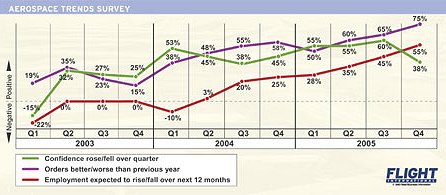More aerospace Top 100 companies looking to recruit as surging orderbooks wipe out worries over costs
 As the Flight International / PricewaterhouseCoopers quarterly Aerospace Trends Survey enters its fourth year, confidence levels and orderbooks among the industry’s Top 100 companies remain buoyant. However, the barnstorming rate at which optimism and orders have been rising for most of the previous two years is beginning to tail off as companies adjust from battling for new business to fighting to cope with a surge in demand.
As the Flight International / PricewaterhouseCoopers quarterly Aerospace Trends Survey enters its fourth year, confidence levels and orderbooks among the industry’s Top 100 companies remain buoyant. However, the barnstorming rate at which optimism and orders have been rising for most of the previous two years is beginning to tail off as companies adjust from battling for new business to fighting to cope with a surge in demand.
The jobs outlook is also at its brightest since the survey began in January 2003, with more than half of our 40 global respondents indicating that they plan to increase employee numbers over the next 12 months, and none saying that they will be cutting staff. In fact, for the first time, there are no negative responses to any of the three questions, with everyone either positive or neutral.
Our confidence question asks whether companies felt more optimistic at the end of December than they did three months earlier. With 15 respondents saying they were more confident and 25 that they felt the same, the balance of 38% is the lowest since quarter three of 2004.
However, because the question measures relative rather than absolute confidence, the picture is still extremely upbeat, says Neil Hampson, a partner at PricewaterhouseCoopers, whose team compiles the survey.

“People are still happy with how things are going, but there comes a point when they cannot continue to say they are getting more confident,” he says. “As long as the number does not become a net negative, then it remains good.” In other words, there are fears about the impact of the high dollar and the rising price of oil and raw materials, the continuing troubles of US major airlines and sluggish defence spending. But these are being outweighed by the high hopes generated by record levels of airline orders.
In any recovery, the jobs market will lag behind as any revival in optimism and orders takes time to filter through to employment levels, and this has been the case with our findings over the past three years. Although companies started to say that their confidence and orderbooks were growing by the second quarter of 2003, it took until the second quarter of 2004 for a net majority of respondents to say that they planned to take on staff.
Now the “jobless recovery” appears to have turned into an employment boom. According to Hampson, the high positive response to this question indicates a sustained recovery, as companies will resist increasing their workforces until they feel secure about medium- to long-term prospects.
"We've noticed that the big companies have been trying to find niche technologies they want" |
NEIL HAMPSON, PRICEWATERHOUSECOOPERS |
Those who say they are more confident include a North American “tier one” company that makes more than 70% of its revenues from defence, and a component manufacturer in the rest of the world with a largely defence-oriented business.
On employment, responses are slightly more positive from Europe, with 12 of the 18 Europeans and nine of the 17 North Americans looking to increase their workforces over the next year.
Hampson believes that for confidence levels not to falter, some consolidation in the industry probably needs to take place, particularly in the lower tiers. The supply chain has not completely recovered after the downturn and inefficiencies remain that hold back growth, he says. This could prompt mergers among smaller companies.
“There are signs that people are beginning to act,” he says. “There’s probably a bit of pent-up demand that might be released this year.” Larger players could also start to cherry-pick technology specialists as they switch the emphasis from “metal bashing” manufacturing to designing systems. “We’ve noticed that the big companies have been trying to find niche technologies they want to own again,” says Hampson.
The Flight International / PricewaterhouseCoopers Aerospace Trends Survey questions the same 40 companies each quarter. All ranked among the industry’s biggest 100 businesses by turnover, they represent prime contractors or airframers and component and system suppliers. Eighteen are from Europe, 17 from North America and five from the rest of the world. Figures are reached by subtracting negative responses from positive responses and expressing the number as a percentage.
HELEN MASSY-BERESFORD / LONDON
Source: Flight International













